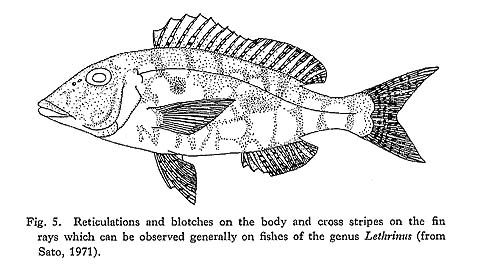V. DESCRIPTIONS
Genus Lethrinus Cuvier
|
Lethrinus Cuvier, 1829: 184. Lethrinella Fowler, 1904: 529. Lethrinichthys Jordan & Thompson, 1912: 558. D. X, 9; A. III, 8; P1. 13; P2. I, 5; C. 8 + 7; L. lat. 44 to 50; Ltr. 5 to 7/i/13 to 17; scale rows between lateral line and median dorsal spines 5 or 6; branchiostegals 6; gill-rakers 4 to 6 (lower) + 4 to 6 (upper); number of vertebrae 10 + 14 (including urostylar bone); pyloric caeca 3. Moderate-sized percoid fishes characterized by a large head with deep suborbital space, scaleless cheek and top of head, and with snout more or less pointed. A single continuous dorsal, the base of spinous portion nearly 1.5 times as long as that of soft portion. Anal base about equal to that of soft dorsal. Pectoral long and pointed, reaching near or beyond the vertical through anal origin. In most species, soft anal base longer than the longest anal ray. Pelvic thoracic, with scaly axillary process. Caudal lunate or emarginate, upper lobe a little longer than lower one. Mouth terminal, slightly protractile. Lips thick and fleshy. Maxillary concealed by suborbital skin and with no supplementary bone. Nostrils paired, the anterior sur-rounded by a fleshy rim. Except in a few species, posterior nostril about halfway between anterior one and orbit. A single continuous lateral line with simple tubes. Ctenoid scales of moderate size cover body, operculum, suboperculum, supratemporals and postorbital area. Other parts of head scaleless. Inner base of pectoral with or without scales. Jaws and teeth strong. Anterior teeth cardiform, with 2 or 3 enlarged outside canines on either side of either jaw. Lateral teeth in a single row, conical or molarlike. Vomer, palatines, and tongue toothless. Gill-membranes broadly united with each other but separated from isthmus. Gills 4, a slit behind 4th. Pseudobranchiae present. Gill-rakers mostly reduced, knob-like. Gas bladder present. Subocular shelf small or vestigial. Color. —Ground color of body and head grayish or brownish with a tint of red, pink, yellow or green, ventral half paler. Dark reticulations and blotches usually observable on the whole body (Fig. 5). Fins yellow, pink, orange, or red, pectoral usually paler sometimes with such cross stripes as shown in Figure 5. Some species ornamented by characteristic color patterns such as red spots or yellow stripes. Lips and lining of buccal and branchial cavities bright red. Apparent color variation extreme in every species, depending upon the condition of dispersal of chromatophores, especially of melanophores. For a detailed discussion of color patterns of this genus, see Sato (1971: 119).
Littoral and carnivorous fishes of tropical or subtropical seas. Feed on crustaceans, echinoids, and molluscs, as well as small fishes, with stout jaws of crushing type (see Al-Hussaini, 1947: 25). Commercially important, flesh delicious. Caught by means of hook and line, spear, gill-net, drive-in-net, or bottom trawl. Belong to the family Lethrinidae together with Monotaxis, Gnathodentex and Gymnocranius. Distribution. —Tropical and subtropical areas of the Indo-Pacific. Can be seen east-ward to Line Is. and Marquesas Is., northward to central Japan, Persian Gulf, and Red Sea, southward to Alagoa Bay and Norfolk I., one species being found along the west coast of Africa. Remarks. —Sato (1971: 124) discussed the propriety of using the genus Lethrinella Fowler by Smith's (1959) definition. |
